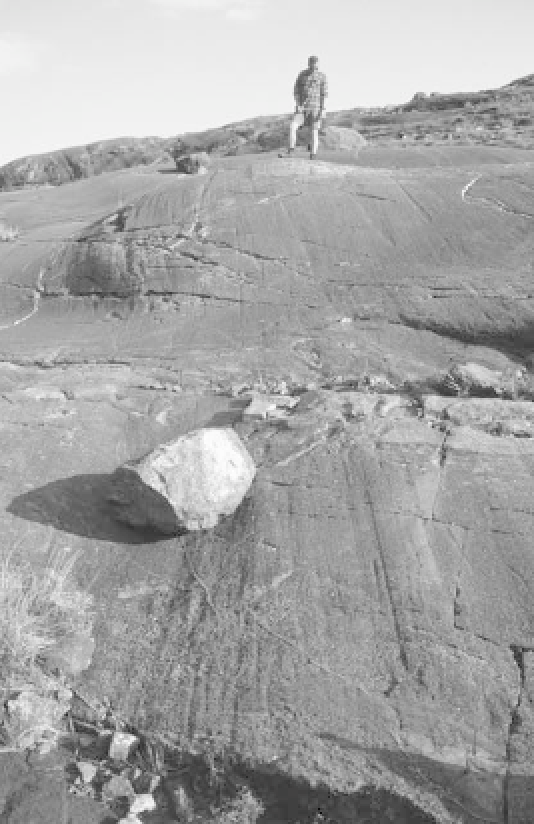Geology Reference
In-Depth Information
Glacial erosion
Glacial erosion is achieved by three chief processes:
quarrying or plucking (the crushing and fracturing of
structurally uniform rock and of jointed rock), abrasion,
and meltwater erosion (p. 266). The bottom of the glacier
entrains the material eroded by abrasion and fracturing.
1
Quarrying or plucking
. This involves two sepa-
rate processes: the fracturing of bedrock beneath
a glacier, and the entrainment of the fractured or
crushed bedrock. Thin and fast-flowing ice favours
quarrying because it encourages extensive separation
of the ice from its bed to create subglacial cav-
ities and because it focuses stresses at sites, such
as bedrock ledges, where ice touches the bed. In
uniform rocks, the force of large clasts in moving
ice may crush and fracture structurally homoge-
neous bedrock at the glacier bed. The process creates
crescent-shaped features
,
sheared boulders
, and
chattermarks
(p. 259). Bedrock may also fracture
by pressure release once the ice has melted. With
the weight of ice gone, the bedrock is in a stressed
state and joints may develop, which often leads to
exfoliation of large sheets of rock on steep valley
sides. Rocks particularly prone to glacial fracture are
those that possess joint systems before the advent
of ice, and those that are stratified, foliated, and
faulted are prone to erosion. The joints may not
have been weathered before the arrival of the ice;
but, with an ice cover present, freeze-thaw action
at the glacier bed may loosen blocks and subglacial
meltwater may erode the joint lines. The loosening
and erosion facilitate the quarrying of large blocks of
rock by the sliding ice to form rafts. Block removal
is common on the down-glacier sides of roches
moutonnées (p. 259).
2
Glacial abrasion
. This is the scoring of bedrock
by subglacial sediment or individual rock frag-
ments (clasts) sliding over bedrock. The clasts
scratch, groove, and polish the bedrock to pro-
duce
striations
(fine grooves) and other features
(Plates 3.3 and 3.4), as well as grinding the
bedrock to mill fine-grained materials (less than
100
Plate 3.3
Striations on Tertiary gabbro with erratics,
Loch Coruisk, Isle of Skye, Scotland.
(
Photograph by Mike Hambrey
)
surfaces, commonly carrying striations, testify to the
efficacy of glacial abrasion.
Rock flour
(silt-sized
and clay-sized particles), which finds its way into
glacial meltwater streams, is a product of glacial abra-
sion. The effectiveness of glacial abrasion depends
upon at least eight factors (cf. Hambrey 1994, 81).
(1) The presence and concentration of basal-ice
debris. (2) The velocity at which the glacier slides.
(3) The rate at which fresh debris is carried towards
the glacier base to keep a keen abrading surface.
(4) The ice thickness, which defines the normal
stress at the contact between entrained glacial debris
and substrate at the glacier bed. All other factors
micrometres
diameter).
Smoothed
bedrock

